-
Posts
1,725 -
Joined
-
Last visited
-
Days Won
50
Content Type
Profiles
Forums
Events
Posts posted by Syzygies
-
-
23 hours ago, tony b said:
Larger quantities (full or half pallets) shipped freight to a commercial address or picked up at the freight terminal are really the only way to go.
This is an empirical question, and the answer may have changed since my last share. Play around with the freight calculator, and pay attention to shipping per box. One captures most of the savings getting a part pallet shipped to a residential address; the "lift gate" bump for not using a loading dock is not ruinous.
The main virtue of a share is getting to meet new owners who haven't yet realized they want a part pallet for themselves.
I still have boxes dating to Sacramento and Mexico "Richard", and I was an early tester for Dennis. He sold on the cheap a first batch that didn't meet his standards, and I have to say it made damn fine barbecue. If Dennis says this is the best batch ever, we should think of it as "manufactured bincho". Go look at bincho prices, if you need help relaxing after ordering a pallet. How much can you store? is the relevant question; I built a charcoal loft in my rear shed.
-
 1
1
-
-
It's been so long, some might not recall the tribal tradition: We bring down in-country trucking costs by forming pallet shares, and driving to meet each other to pick up our orders.
It's been fun meeting people this way, over the years.
-
 1
1
-
 1
1
-
-
2 hours ago, C6Bill said:
Take a look at Stargazer. Nice cast iron, in my opinion, at a decent price 👍
-
 1
1
-
-
2 hours ago, David Chang said:
carbon steel roasting pan made by blanc creatives
Expensive, but they look worth it. I love my faux cast iron (leaning carbon steel) pans. Best of both worlds.
My Dad built furniture from pine. You used to be able to buy decent pine; you can't anymore. My ancestors used to cook in cast iron. You used to be able to buy decent cast iron. You can't anymore.
-
19 hours ago, fanie2200 said:
Shuns are a pain to sharpen…they sharpen them for free but at ups 30$ each way to Them, it gets expensive.
What do you mean? I have Shapton glass stones 500, 1000, 2000, 4000, 8000 along with the holder and a sink bridge. My various VG-10 Japanese knives sharpen like a dream, while Laurie prefers the shape of her WÜSTHOF knives. They are much more difficult to sharpen, unless one wants to brutalize them in some grinding machine. She's spoiled by how sharp I keep our Japanese knives.
So I bought her a couple of Shuns, replacing her favorite WÜSTHOF paring and utility knives. They came nicely sharp, so I haven't tried to sharpen them yet.
What am I missing? Why are they a pain to sharpen?
I have to say, rounding the exposed corner everyone cuts themselves on is pure marketing genius. Shun is a Japanese knife that understands the international market.
-
Those loaves are beautiful.
I tried keeping it simple with freshly ground flour, which is healthier and tastes better. They came out like Colorado cow patties. I had to claim I was making Moroccan bread.
You identify the psychological crux of cooking. On one hand, most technique is unneeded embellishment that one wants to see through, and strip away. On the other hand, a typical day for most of us involves less manual dexterity output than five minutes of practice for a concert pianist. Some time ago I learned not to fear complexity in cooking, and my cooking got better.
I remember cooking for a beach house, with people nursing drinks across the counter. They wondered how I could work for an hour like that. I wondered how they could stay still like that.
The art isn't in minimizing effort, it's in not wasting effort.
-
 1
1
-
-
I've been exploring a new theory for handling wetter artisanal doughs, in our case with a majority of freshly ground flour: Rethink how and when one adds water, for maximum advantage.
The whole grain flour needs to hydrate, white bread flour less so. It's easier to knead a conventionally less wet dough. Even after sieving, whole grain flour has bran that cuts through gluten like shards of glass.
Putting this together, I hydrate the whole grain flour, setting aside some white bread flour for kneading on the board. I aim for a dough hydration that's easy to conventionally knead on a board, reserving the rest of the water for later kneading in a bowl.
I love the "turn and fold" knead in a bowl, as described by Chad Robertson, but freshly ground flour is a challenge few people face, and I find this kneading by itself insufficient. The "no-knead" crowd isn't lazy; they're just not using my flour. I need all the gluten formation I can manage.
I like to bench knead by rolling out a long rope of dough with my hands, folding it over on itself, making it longer, folding it over, ... This creates a definite grain to the gluten, like the grain in wood. Recall that half of all woodworkers are oblivious to all the issues and opportunities presented by wood grain (ever see an end grain cutting board with a side grain border?). Here, my approach minimizes the damage to the gluten by shards of bran. In my experience, a stand mixer instead maximizes this damage.
I then fold in the remaining water in the bulk rest bowl, and return regularly with wet hands to fold some more. There are limits to how much water one can comfortably add at this stage, so one wants as wet as possible a dough for the bench kneading step. Just not too wet to support conventional kneading, stretching and folding over ropes of dough. One can't do this with sticky glue, so the usual advice for wetter artisanal doughs involves a different kneading technique I don't enjoy. This modification avoids that, and develops better gluten.
Forming the loaves, it is important to work with the gluten to help the loaf hold together. Gently press out a rectangle, then roll to form a batard held together by its gluten structure.
-
11 hours ago, David Chang said:
2. after an hour of heating up, place loaf on top of stone. add about 500g of ice in the drip tray.
3. bake for 30-40 min until done.
i saw in the other thread someone put chains in a cast iron pan. is this necessary?
should i use my guru to maintain temp?
Hi David,
People have been baking bread since time immoral, and there's no right way. As a student of making bread, I've learned the most from people who are self-taught, such as Chad Robertson. Start out with hints from others, then become self-taught! Advice is most useful when one is stuck. Otherwise, the truths can be discovered by experiment, if they're more than cultural habits.
Commercial bread ovens use substantial steam in the early minutes of baking; the ovens are designed to deliver this steam. It takes a great deal of energy to convert water to steam, and this energy is delivered back to the one cold object in the oven via condensation: The bread. This is obvious if one imagines how it would feel to stick your arm in at this point; wetting the crust is secondary.
In the Bouchon Bakery cookbook, Thomas Keller popularized the idea of creating ample steam in a home oven. Many people are terrible at scale, and were content with a few grams of water from a plant spritzer, so Keller's advice was met in worldwide cooking forums with one of the more amusing and ignorant monkey chatterfests in recent memory. I was more concerned that the rocks he proposed would blow up, so I stuck to his suggestion of a stainless steel chain, along with a heavy aluminum scrap disk from eBay. (Betty Crocker learned to sell cake mixes by letting consumers add an egg; finding this disk on eBay was my egg.) Eventually I ditched the chains and moved the disk from rusty cast iron to an aluminum cake pan.
Skipping the math, steel and aluminum hold far less heat energy by weight than water, and most of the energy in steam is from the transition to steam itself. Put together, each 100g of steam requires much more heated metal to deliver. How much steam does one need? 500g is enough to displace the air inside a KK several times over, probably reaching diminishing returns. Does one even need to displace the air once, or will a mixture of part steam find the bread? This is an empirical question. Commercial ovens are worried about not delivering too much steam; we're worried about delivering enough.
What does your drip pan weigh? What do you estimate the volume of your KK to be? I could redo the math here. But start with less ice! Peek after the steam subsides; if your ice didn't all melt you used too much for your weight of drip pan, risking a now-cold pan bringing down your baking temperature.
Baking bread in a Dutch oven is very popular, and works on somewhat different principles, but is also effective. We just don't like round loaves, but I discovered The Challenger Bread Pan, which supports making shorter batards. One can add a few ice cubes, all that is needed for such a small volume, and have it both ways. Bread bakes first covered then uncovered, diminishing the effects of the fire. We bake bread in the KK summers in part to avoid heating the house (we "sail" the house by changing the air overnight, rather than using A/C), so the KK is still useful here.
One can use a guru to control a KK at bread temperatures. While they make probes with wiring that can withstand the heat, it's easier to just push the probe through the thermometer hole in the dome, controlling how far it goes in with an alligator clip. I tend to do this as a default, as before equilibrium in any cook I'd rather key off the dome temp.
However, this is situational, you'll hear a chorus exclaiming this isn't necessary. Stabilizing a KK at bread temperatures is easy and requires a minuscule amount of intervention. Do you have this attention, or are you off in the kitchen making seven other dishes, or walking the dog while the bread proofs? Your call, try it both ways so you have a choice.
-
 1
1
-
-
On 2/16/2022 at 7:49 AM, tony b said:
2) move the lid latch to the 1st position to take the pressure off your gasket.
Wow. Old-timer here. I'm embarrassed that I never asked myself what that first position was for. Can one still extinguish a fire, saving remaining charcoal, in first position?
I've actually never had my top damper get stuck, without knowing this. I have learned on this coast not to tighten jar lids too tight if I want to stay married; maybe my top damper habits are just my California mode.
A friend once had an off-brand cooker (K5, for other old-timers) get its damper stuck after a winter of disuse. We needed to use some solvent that needed to be cooked off, and an improvised strap wrench. One needs leverage, or else one could get hurt, but not so much leverage that one destroys the cooker. For comparison, there's an old Pavoni Europiccola out there (we gave it to a friend) with a badly dinged main body from a misguided strap wrench episode. We ended up soaking the errant joint in acetone for an hour; that worked.
-
 1
1
-
 1
1
-
-
23 hours ago, Poochie said:
I dumped it all out and started over with Royal Oak lump briquettes...Tony's favorite.
I'm trigger happy to start over given the slightest provocation if there's time. I'm reminded of Laurie and my stepdaughter: "No Mama! It's dead."
-
4 hours ago, tony b said:
1) the size you want; 2) the color & tile style you want; 3) within a reasonable driving distance; and 4) up for sale in the next few months.
1) 23" or 32" 2) who cares! 3) some of us really like a good excuse for a road trip, the longer the better the stories...
4) is the kicker. If nothing turns up he just buys. One forgets the pain of purchase quickly. The joy of a good cooker is forever.
-
 1
1
-
-
I want a Berkel! I would, except for storing and cleaning.
-
 2
2
-
-
Music to decide by?
-
 1
1
-
 1
1
-
-
Yes. The forum search will find old threads on this. I like it. Pricey, more flavor than the very neutral KK extruded coconut. It reminds me of roadside barbecue in Thailand, which I miss. Definitely worth a try.
-
 2
2
-
-
On 11/21/2021 at 1:00 PM, tony b said:
You guys are making my brain hurt worse than a Syzygies dissertation!
We just enjoyed Thanksgiving with the family of a mathematician friend and colleague. There was no apple pie. A Lamaze recommendation to bring apples to her delivery left an impression on their adult daughter. Of course I recommended Cien años de soledad.
Great things can come from obsession. The waves are a gift. One needs to learn to surf.
The Beatles couldn't read sheet music. Cooking is learning to see the simple.
-
 2
2
-
-
5 minutes ago, johnnymnemonic said:
As a Braves fan I still almost feel like 2-0 is not enough of a lead against these guys.
As a Giants fan, ask me how I know!
-
Take into account how liquids take on smoke more quickly. If you like the effect but it's faint, you're on the right track. If the results are wretched, it could be either that you don't like smoked milk, or you used too much smoke.
I prefer to have the chicken itself carry the smoke into the stew.
In the late eighties I visited New Orleans on a soon-to-expire airline bump voucher, and ate over a dozen gumbos. Then I was visiting Nice, France with a friend, and had this idea of getting invited over to people's houses to cook dinner parties. Cooking French for the French didn't make sense, but I was impressed how Alice Waters had transported the idea of Provence to California, founding Chez Pannise. I thought, turn-around is fair play, I'll bring New Orleans to Nice and make a Mediterranean gumbo.
My friend rolled his eyes at the implausibility of this fantasy, but humored me. A Chez Panisse connection? That's over-thinking things, like the LA Dodgers.
A complication for my second host (a dear, now departed friend who made me feel French) was that they kept strict kosher. I wasn't allowed to make the stock. I spent what would be over $100 now on amazing vegetables at the farmers market. Soon we realized we were making an overhyped chicken soup, with twelve guests about to arrive. Jacques came up with the idea of smoking the chicken over vine cuttings. Back in the gumbo, the smoke came up like a house fire, then ... then ... stopped at just the right point.
To my surprise, one of the coauthors of Chez Panisse Pasta, Pizza, & Calzone arrived, expresses her pleasure at an American who cooks. Then everyone is stunned, Jacques kindly (a clear lie) pronounces our gumbo the best meal served in his home. My friend and I get a return invitation a few nights later, learning to make pizza in the home and garden illustrated in the pizza book.
-
 2
2
-
-

Yes, you don't need a ceramic cooker heat deflector, any more than you need a trombone mute.
Nevertheless, people like to "shape" the fire in a cooker, just as they like to "shape" the sound from a trombone. In both cases there are long traditions of using found objects, such as terra cotta plant saucers and toilet plungers, respectively.
Some people inexplicably have trouble reaching higher temperatures in a ceramic cooker. A heat deflector makes this harder, but with good technique one won't notice a difference.
Be sure to leave an inch or more on all sides, and buy an unglazed plant saucer to minimize the risk of lead. (As an aside, galvanized metals off-gas toxins. Like choosing smoking woods, only use materials in a BBQ that have a long-standing tradition of tested historical use. Even here, one might question the choice of used oil drums by Texas oil workers for their BBQ rigs. Err on the side of caution, and be aware of what one does not know.)
Terra cotta plant saucers are easily lined with foil, for easy mess disposal after a cook. They eventually crack. I went through a saucer every several years for a long time, before moving on.
-
 1
1
-
-
Nice! We get their flyers but I didn't spot this; we use KA flour whenever we aren't grinding our own. I look forward to someone making a comparison.
I have two data points: We've made nixtamal from Anson Mills Henry Moore Yellow Hominy Corn, and we've bought prepared artisanal masa from Primavera at the Sunday Ferry Plaza Farmers Market in San Francisco. Both are based on domestic US corn, and both masas were excellent; Primavera is my favorite Mexican restaurant in the Bay Area. However, we preferred masa made from corn grown in Oaxaca, Mexico, as sold by Masienda.
Masienda sells masa harina (masa flour) in red, white, and blue. We use the white to dry out too-wet masa mixtures from our Indian wet grinder.
I'd like to compare the Masienda white against the KA masa harina.
-
1 hour ago, MacKenzie said:
I think I need my head examined. I cooked this on the KK and I was so shaken up by the experience that the pix is even blurry.
Haddock on the KK.
Shaken? Or stirred?
-
 3
3
-
-
11 hours ago, johnnymnemonic said:
here's a hilarious video - can't believe they let this crap stay up there if this is still a serious product.
What I find most astonishing: They're priced comparable to a KK. At least Richard's K's were priced as starter marriages.
-
Typical Sunday at the ranch. I processed two 20 lb boxes of Santa Cruz dry farmed Early Girl tomatoes into Sicilian estrattu (paste) overnight, still working in the dehydrator I built. Shown is what's left of one box after 24 hours, more than it looks on a full sheet pan. This morning I picked up 15 lbs each of chicken bones and vegetables for stock, filling a 22 quart commercial pot to the brim. Oh, dinner, right. A pheasant in the KK.
-
 9
9
-
-
6 hours ago, Newbie1925 said:
Hello all,
Hi! You do realize your handle will be an inside joke, when you make your 1000th post as an expert in 10 years?
You don't need a controller. I'm always amazed how I can hit a target temperature first time I check, after lots of experience. It can wait, and you'll never learn if you don't try not using one. But you want a controller. If you do something that found the money for a 42, your idea of recreation is probably also doing seven things at once. (Today I have estrattu working from 40 lbs of Santa Cruz dry farmed Early Girl tomatoes (in a dehydrator I build myself), and a 22 quart stock pot filled to the brim with chicken stock, and I should really be lighting a fire for pheasant rather than answering you.)
When you're doing seven things at once, a controller is welcome.
-
 1
1
-
 1
1
-
-
Looks to me like a Richard K5, not a KK. Very different construction, perhaps $600 new. Has all it's tiles, so looks never used.
I've made decent Q for a crowd on this, a friend bought a K5 when I bought a K7. My K7 fell apart, even my neighbor sent it to the dump as his tastes evolved. But let's remember, Texas Q started with metal worker off hours converting oil drums to offset cookers, with the right skills one can make great Q in a ditch.
A KK is a Lear jet. This is not that.
-
 3
3
-
 1
1
-



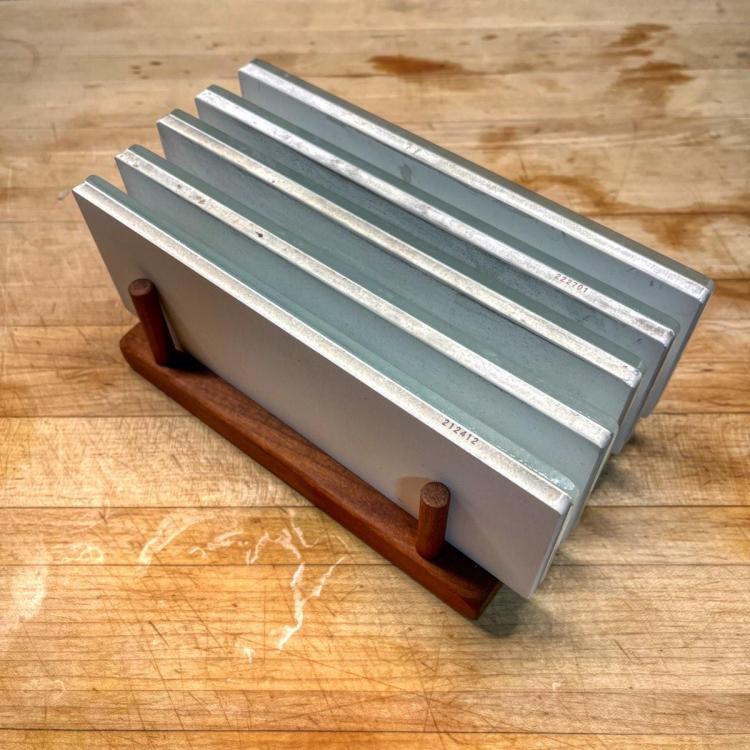
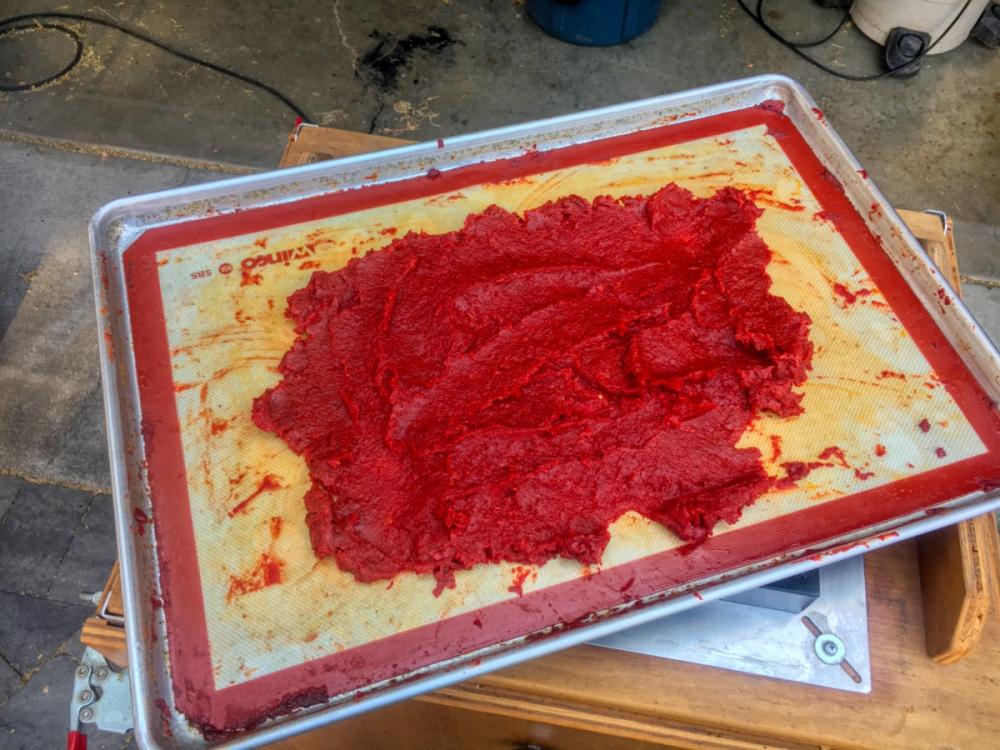
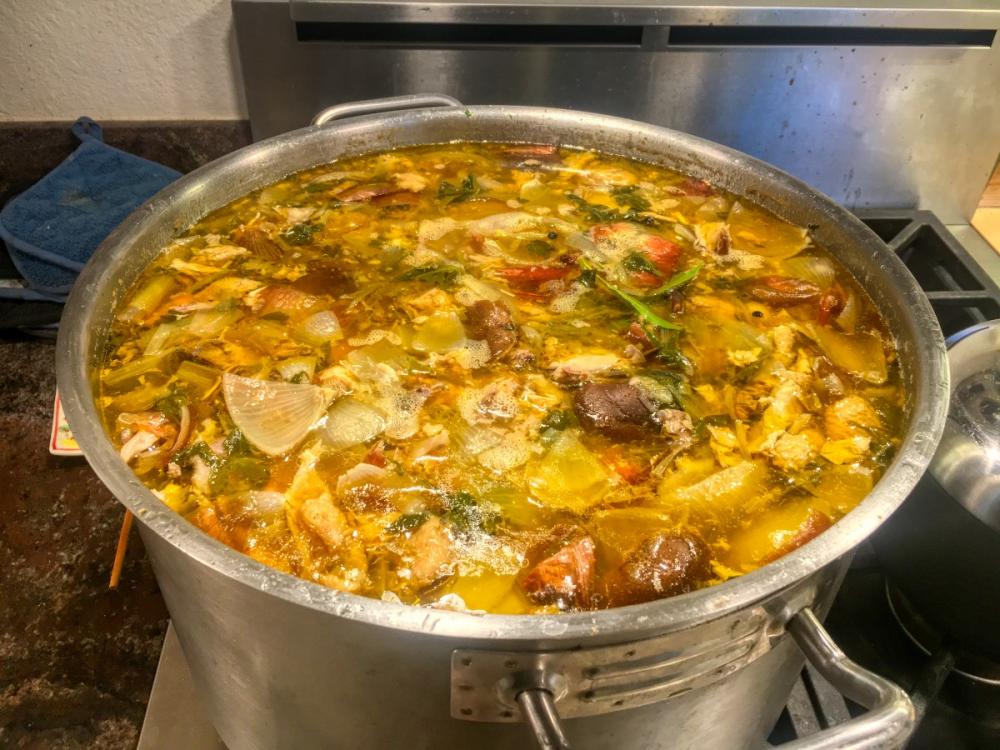
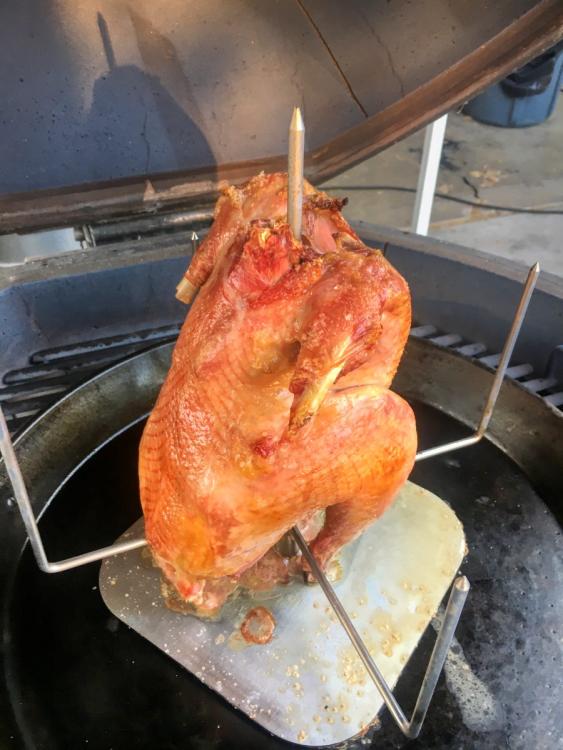
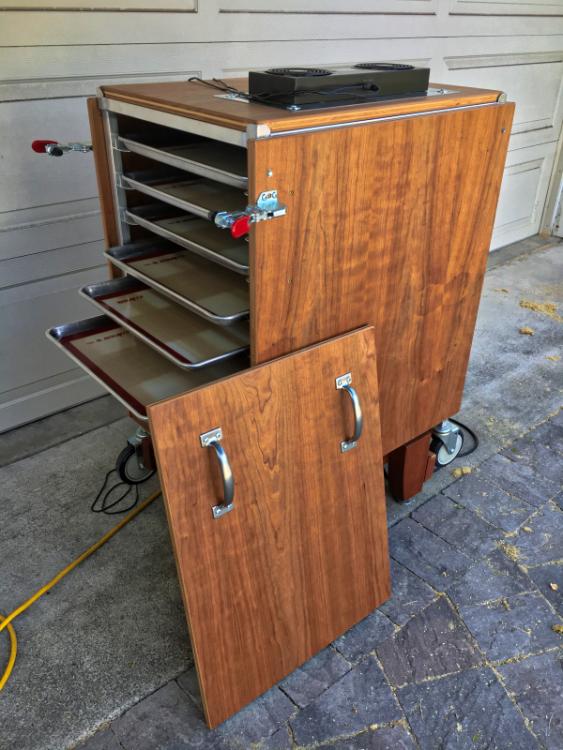
Non KK cooks
in Lagniappe Photos
Posted
There's a classic issue here: Anyone who tries grinding nixtamal into masa for corn tortillas using inferior equipment to at least an Indian wet grinder just gives up. The least expensive grain mills for flour (ignoring mills that require hearing protectors) are made by MockMill:
Mockmill 100 & 200 grain mills
I have an older wooden model in both kitchens. While these new models aren't as attractive, they're said to grind even better.
Use an inferior mill such as a Vitamix (I own two) or a stand mixer attachment, and you won't see the point.
Even so, there's a host of issues with freshly ground flour. I have various lab sieves (I prefer the #35) for sieving out the coarser bran, for flavor and to protect the gluten. It needs to hydrate like crazy, and takes more muscle to work. It's what professional bakers call "green" (not aged) flour, which can interfere with bread dough unless one adds 60 ppm ascorbic acid.
Nevertheless, it's alive! The germ is freshly ground, the flavor is wonderful.